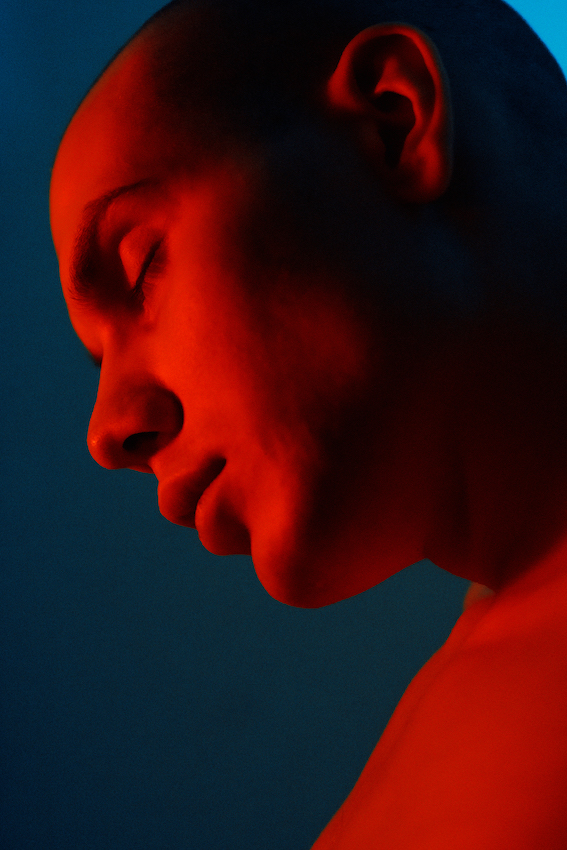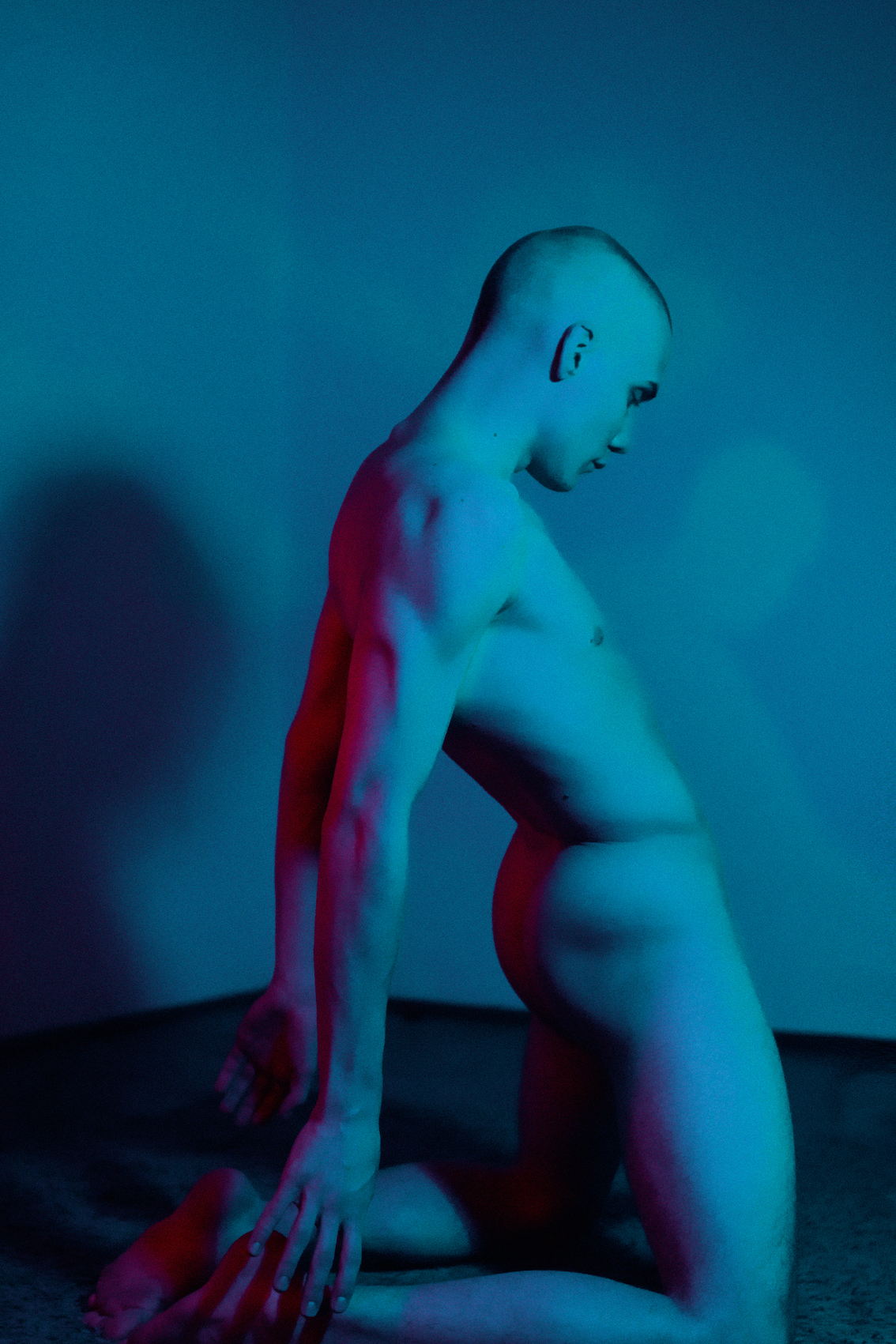The Metalhead redaction talking to Warsaw-based photographer Leo Maki. Works of the young talent are characterized by sensual erotism in male portrait and mixed light effects.
Leo, thanks for talking to the Metalhead magazine! Could you please shorty introduce yourself to the readers – just in one sentence
My name is Leo Maki, 26 years old photographer and videomaker based in Warsaw Poland, trying to capture sensuality, creating intimate shots of my meetings with models.

You have unique style, male body, portraits photographed in low lights, with colored light effects. Did it take long for you as a photographer to find your own style? Were you experimenting with different cameras and light for the first time?
I’m aware that it may seem I got a very concrete style, but in reality it’s an endless journey and never ending experiment. I really like using strong contrasts and powerful colors, but for me it’s changing and evolving all the time. Each shoot I try something new, seek for new solutions. I know what I like and what I don’t like in general, but I want to keep my mind as open as possible.
Can you tell us a bit about how you became a photographer? Is photography your main occupation or it’s something that you make from time to time?
I never finished any particular school or attempted any courses. I believe the best way of learning is through experience, finding out how you like to work, what inspires you and what you’re most interested in. Of course objectively it means making thousands of „mistakes” in the process, but I wouldn’t actually call it this way. I was working constantly for several years now and thanks to that I can see a real progress – mostly in my approach to things, I’m much more aware of what I’m doing. I see photography and videography as my main occupations right now, slowly moving to a place where I can support myself fully doing what I love. But I really like to keep the balance between creating art and regular life. Sometimes I do jobs that are completely not connected with art whatsoever – as a teenager I really wanted to be a babysitter as the ones I’ve seen in american films and lately I was able to try it for some time. I’m really glad I’m in the place in life where I can make those decisions consciously, just experiencing life.

Leo, is taking male pictures of your style, intimate, nude – a thing that you are creating for the soul, for expressing yourself as a photographer? Can it also be commercially successful?
For sure what I do is some kind of niche that won’t be appealing for everyone. The most important to me is to create in harmony with myself. Sometimes it brings profit, sometimes it doesn’t. I see ways to make it more commercially successful thou, I got few ideas. It’s a bit of a risk, but I’m up to it.
Why did you choose for yourself male photography? Is it bound with your vision on beauty, sexualily or has some special idea behind it?
I don’t see my work as a traditional portrait photography work , it’s more like a documentation of a meeting with an individual. Being gay I think it’s important to represent queer community, so even thou right now it looks like it looks like – which is gay guys mostly, I’m up to create with all the people with opens minds, boys, girls, all in between and outside those terms. I don’t have a fixed idea of beauty. Although it sounds very cliché I believe it comes from the inside, so with trust we build between each other with the model, the outside becomes a reflection of that.


A perfect model – who is it for you?
A perfect model is a person who’s up for experimenting, fooling around, not scared of showing vulnerability and fragility. Someone who doesn’t treat themself too seriously, open for a dialogue. What I tell my models at the beginning of the meeting is – whatever idea about what we’re going to do, you prepared in your head before you came here, just throw it away and allow yourself to be.
What atmosphere do you need on the shoot, to create something special? Loud music or silence, big team around or being alone with your model?
I’m not a fan of big teams when they’re not really necessary, as much as possible I prefer to keep it only me and the model. I also don’t like big spaces, studios, big professional photography lamps. It’s all about the atmosphere, I prepare the place almost like for a ritual – lights and shadows, music, smell of incense. There’s a lot of talking, exchanging music, sharing thoughts about life and death and when we’re ready we’re ready.


Can you share your favourite or most memorable picture and tell what is the story behind it?
It’s a self-portrait I shot last December, first time I posed nude for myself. It made me realize how much trust I receive from people who work with me. Also it allowed me to get a bit of a distance from my perception of myself. Plus, I consider it a picture that started everything for real for my art.
Have you ever had bad experiences, „horrible“ shoots, days when you had no inspiration? If yes, how did you overcome the feeling of dasappointment about that and found new motivation to create?
Of course it happens sometimes, we’re just people and in the times we live in it’s not always possible to be 100% focused, inspired and ready to create. I think the most important thing is to not treat it too seriously. Just get upset or angry or frustrated for a moment if you really need to, then let go and come back on track.
How do you get inspired? Who are your favourite creators, in photography or art, literature or cinema?
I do not necessarily seek for the inspiration, it comes and it goes. For sure the biggest influence on what I’m making comes from the movies I’ve watched in my teens. It’s all mixing and blending in my head, melting into one, it’s torn apart and joined again to become the final image. I don’t think about it at all when I’m shooting, but then while editing it comes like „Oh, this gives me vibe of this film, but with the twist from this film, and this one and a pinch this one”. During the work the biggest inspiration for me and the model is the music. I chose it very carefully and allow it to lead us through the process.
Let’s talk about this picture a bit (on the right/below). Who is on this photograph? Do you remember this day, vibe, some interesting story about this shot?
It’s a very special photography for me. With Vadim we’ve met on the night of January 1st 2021, after both of us not having the craziest night New Years Eve. We were creating in complete freedom, he opened himself fully to me, for that I will be forever grateful. He made me realize that I can be pushing boundaries I’ve put on myself before, by working with people who are willing for the experience. Until now it’s one of my favorite shoots I’ve done.
What is a perfect picture for you? How do you decide for yourself, which picture is good and which one is not? Is it the question of technique (like right lighting, perfect pose and composition) or some artistic intuition?
It’s all about the moment. I allow my models to express themselves freely and rarely ask them to repeat something or freeze for a long time. This way I’m loosing a lot, but at the same time gaining something different – authenticity. I prefer to talk a lot (a lot) before the shoot and during the breaks, but work in silence when we’re actually shooting. We spoke, we know each other a bit, now you give me something and I’ll document it. Don’t ask me if you can do this or that, just do it and I’ll be there to take the picture. I don’t care for the right lightning, perfect pose or the composition, if there’s something in your eye, the rest will be fine.



Is there some „secret recipe“ of a good picture – some special light, colours around, place or some other things?
Every photographer has their secret. And mine happens to be a little bigger. What exactly is my secret? Why, it’s Maki’s secret. For the desire and the inspire.
Your top-3: books, movies, photographers?
It’s very difficult to decide, since it’s constantly changing. I can give three names that I come back to often since many many years, which mean a lot to me. Those are Herbert Rosendorfer (author), Pedro Almodóvar (director), Nan Goldin (photographer).
